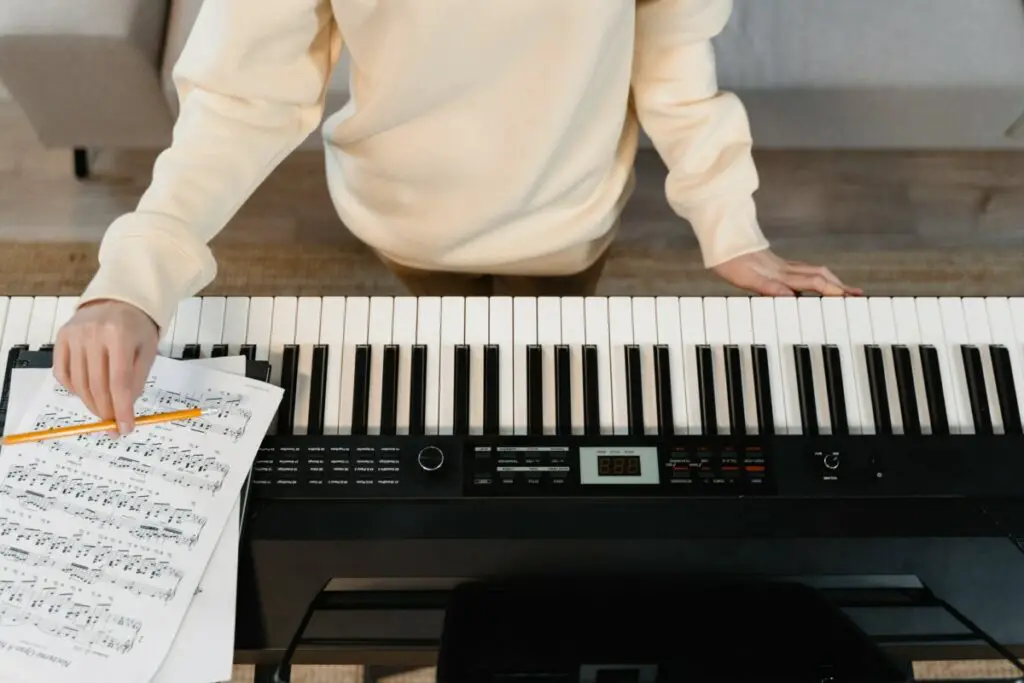This post contains affiliate links.

As you are pondering between getting a digital piano or a real acoustic one, you may also wonder if a digital piano can provide you with the same feels like a real piano. This makes sense since a digital piano is but an imitation of an acoustic piano. And imitations can’t beat the originals.
Or can it? As a certain man once said: ” But there is no rule that says an imitation cannot defeat the original.”
As a general rule, the more money spent on a digital piano, the closer in sound and feels it will be compared to a real piano. Usually, $900-$1300 is a good range for a decent digital piano that sounds and feels like a real piano.
This article will go over in more detail why a digital piano can feel like a real piano, along with some other questions regarding digital pianos like the differences between digital and acoustic pianos, the costs between them and why getting a good digital piano is better than getting a bad acoustic one.
What do digital pianos imitate from real pianos?
Digital pianos mimic the key resistance produced when a piano key is pressed. The key resistance is produced on an acoustic piano by having the hammers hitting the strings inside the piano.
Digital pianos also reproduce similar sounds to a real piano, but by replaying pre-recorded sounds through a speaker when a key is pressed, as opposed to sound coming from the vibrations of the strings when being hit by hammers in an acoustic piano.
Do digital pianos feel like real pianos?
As said above, usually, you will be able to obtain a digital piano that sounds and feels like a genuine acoustic piano if you spend more money on it. This is because a higher price means that higher quality materials are used in the construction of the digital piano, along with it having access to better technology, in order to better mimic a real piano.
Of course, it should be noted that the higher price could just be because of the brand name. Similar to how a pair of Gucci socks can cost $200, and its quality may be on par with the one you can get from Uniqlo or H&M. After a certain price, the best materials have been used, and the rest of the price could be because of the reputation of the brand.
Also, the skill of a manufacturer is also at play here. For digital pianos at the same price range, how closely a digital can mimic a real one, comes down to the skills of the manufacturers, what kind of method of construction are they using.
There are a lot of choices to choose from when it comes to digital pianos, depending on your goals and needs: the Clavinova 685 have a very realistic feel, the Avantgrand n3 feels identical to a grand piano, or the Alesis Recital, which offers you the full functionality of a real piano at a very affordable price.

Differences between a digital and a real piano
A typical grand piano works by having hammers hitting the strings each time a key is pressed, and a sound is made through the vibrations of the strings. A piano can have over 200 strings, 3 strings are connected to each key, with some having only 2 strings, along with a hammer to hit those 3 strings at the same time to produce sounds.
An upright piano works using the same principle as the grand piano, only the layout of strings and hammers are different. In upright pianos’ cases, the strings run vertically and the hammers strike them by moving horizontally. This results in the tall heights of the upright, making them compact and suitable for homes or smaller spaces.
A digital piano, on the other hand, doesn’t use strings and hammers. Instead, whenever a key is pressed, a signal is transmitted to the computer inside the digital piano, telling it to play the pre-recorded sound corresponding to that key through the speaker.
Of course, more advanced digital pianos will be able to play pre-recorded sounds loudly or softly depending on how hard you hit the keys, just like a real piano.
Costs between digital pianos and real pianos
A low to mid-tier upright piano can cost anywhere from $1000-$3000, while a digital piano is usually cheaper, with some costing as low as $200. Keep in mind that digital pianos have higher resale values compared to real pianos.
A good digital piano is better than a bad acoustic piano
If you are on a budget and are wondering whether to get a digital piano or a used acoustic piano, thinking that an acoustic piano provides better qualities in terms of sounds and feels, you should know that a digital piano is always the better option compared to a used acoustic piano because:
- Beginners won’t be able to tell the details and nuances that separate a digital piano from an acoustic one.
- A used acoustic piano means that it could be out of tune. Unless you tune the piano, it can have a big negative effect on your playing skills since you’ll develop a false sense of pitch from hearing the incorrect notes. To learn more about the effects of an untuned piano, check out What An Untuned Piano Can Do to Your Skills as a Pianist
- A digital piano doesn’t require tuning like an acoustic piano. This means saving at least $100 each year by just owning a digital piano.
- Furthermore, digital pianos have the ability to adjust volumes and plug in headphones. This is undoubtedly important if you live in an apartment building that has thin walls between its flats. Although your neighbours may not mind hearing free piano music every now and then, it’s better to have that feature in case you have the urge to play piano at 3 AM in the morning.
The most budget-friendly “digital piano” that feels like a real piano

As mentioned above, the Alesis Recital is a great option for beginners looking for a piano keyboard that is as close to a real piano for the price, while simultaneously won’t put a hole in their wallets.
At just $200, the keyboard offers you the most important feature in a piano, which is non-existent in pianos of the same price range, that is a full range of 88 keys. This means that you won’t be limited to what songs you can play just because the piano doesn’t have enough keys that you need.
It also has semi-weighted keys to give you a similar feel to playing a real piano, although I do find it difficult to get used to the real weight of a piano’s key once I transitioned and upgrade my piano.
While the sound isn’t out of this world, it’s not bad either. Besides, a beginner won’t be able to tell the details and differences between pianos like a pro player can. The more important thing is that the keyboard produces the correct pitches to the notes.
Final thoughts
As you are looking into getting a digital piano or keyboard, you may also wonder if you need a piano pedal for it. This article will explain why you should get a piano pedal, especially if you’re a beginner.

